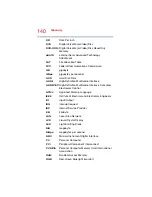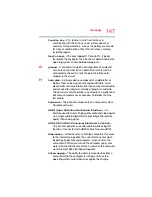
Glossary
147
Function key
—(1) A feature in which certain keys in
combination with the Fn key can set system options or
control system parameters, such as the battery save mode.
(2) A key or combination of keys that activates a memory
resident program.
function keys
—The keys labeled
F1
through
F12
, typically
located on the keyboard. Their function is determined by the
operating system and/or individual programs.
G
ground
—A conductor to which all components of an electric
circuit are connected. It has a potential of zero (0) volts, is
connected to the earth, and is the point of reference for
voltages in the circuit.
H
hard disk
—A storage device composed of a rigid platter or
platters that can be magnetically coded with data. Hard
disks hold much more information than some external media
and are used for long-term storage of programs and data.
The primary (or only) hard disk in a computer is usually fixed,
but some computers have secondary hard disks that are
removable.
hardware
—The physical components of a computer system.
Compare
software
.
HDMI (High-Definition Multimedia Interface)
—An
interface used to transmit high quality audio and video signal
via a single cable in digital format, providing better picture
quality than analog signal.
HDMI-CEC (HDMI Consumer Electronics Control)
—
One A/V component can control another while using this
function, if connected with HDMI cables. See also
HDMI
.
Hibernation
—A feature of many Toshiba computers that saves
to the internal storage drive the current state of your work,
including all open files and programs, when you turn the
computer off. When you turn on the computer again, your
work is returned to the same state it was when the computer
was turned off. See also
Sleep
,
Suspend
.
hot swapping
—The ability to add or remove devices from a
computer while the computer is running and have the
operating system automatically recognize the change.



























